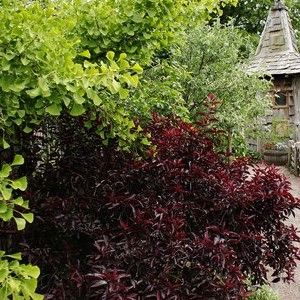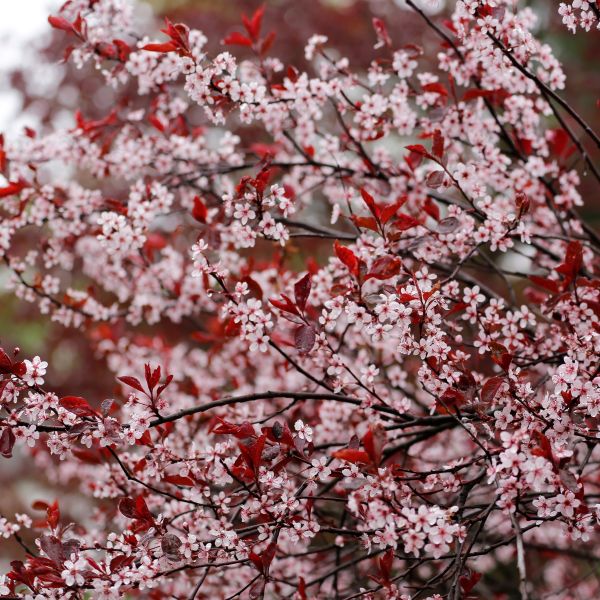


Purpleleaf Sand Cherry
Prunus x cistena
87 reviews
Purpleleaf Sand Cherry
Prunus x cistena
87 reviews
- Beautiful deep purple foliage adds color to any landscape
- Resistant to most pests and diseases
- Tolerant of various soil types and drought conditions
- Recommended by landscape designers for optimal fit in real yards
$79.00
$113.00
30% Off
- Ships to in 3-5 Days
- Free Shipping Over $150
- Plant Arrival Guarantee
- In Stock
- Free Plant Consult
$200 - Landscape-Approved: Every Plant We Sell Comes With Design Expertise Behind It
2.5 Gallon
We are sorry, product is currently out of stock due to seasonal availability. Please check the "Related plants available in your area" section below
Not just beautiful - intentionally selected by ShrubHub's 3D landscape design team to fit real-world spaces and maximize yard potential.
Why Purpleleaf Sand Cherry?
Purpleleaf Sand Cherry (Prunus x cistena) is a deciduous shrub renowned for its stunning purple foliage and beautiful pink flowers. It typically grows up to 6-10 feet tall and provides a stunning color contrast in gardens and landscapes. This plant is easy to grow and care for and is ideal for adding color and texture to any garden. Overall, the Purpleleaf Sand Cherry is a hardy and versatile plant that can thrive in a wide range of conditions.
Sunlight
Purpleleaf Sand Cherry requires full sunlight to thrive and produce vibrant foliage and flowers. It should be planted in an area that receives at least six to eight hours of direct sunlight per day for optimal growth and performance.
Watering
Purpleleaf Sand Cherry prefers well-drained soil and regular watering, especially during its first growing season. It requires consistent moisture, but avoid overwatering to prevent root rot. Once established, it can tolerate periods of drought but will be
Fertilizing
Purpleleaf Sand Cherry typically requires a balanced fertilizer with a ratio of nitrogen (N), phosphorus (P), and potassium (K) such as a 10-10-10 or 14-14-14. However, it is recommended to conduct a soil test for accurate fertilizer application based on i
The purple leaf sand cherry bush, also known as Prunus x cistena, is a deciduous shrub that's native to North America. It's notable for its striking, rich purple leaves.
In early spring, the purple leaf sand cherry bush produces small, fragrant pink flowers to white flowers that attract birds and pollinators. The stunning clusters of pink and white flowers form a captivating effect against the reddish-purple foliage.
The flowers even give way to small, reddish-purple fruit in the summer that are not typically eaten by humans but are enjoyed by wildlife.
The Purbleleaf sand cherry tree can grow up to 8 feet tall and 6 feet wide. It's a very hardy plant that is tolerant of a wide range of soil types and conditions, from sandy to clay soils. It can adapt to cold winters as well as to hot summers. It's perfect for hardiness zones 3 to 7.
With the full sun and moderately moist, well-drained soil, it grows to be a stunning small tree, beautiful shrub, hedge, or border plant. It's generally tolerant of partial shade but produces more abundant beautiful flowers in a planting location with full sun.
However, the purple leaf sand cherry bush is susceptible to the few diseases and pests that plague the rest of the rose family. Regular pruning and maintenance can help prevent these issues and keep the plant healthy.
Overall, the purple leaf sand cherry bush is a versatile and attractive plant that is well-suited to a variety of garden and landscaping settings. With proper care and maintenance, it can provide years of beauty and enjoyment.
Plant Information:
| Botanical Name: | Prunus x cistena |
| USDA Zones: | 4 - 7 |
| Water: | Moderate |
| Exposure: | Full Sun |
| Soil Needs: | Well-Drained |
| Mature Height: | 6 - 8 feet |
| Mature Spread: | 7 - 8 feet |





Pollination Info
FAQ
Purpleleaf Sand Cherry (Prunus x cistena) is a deciduous shrub that is prized for its beautiful purple foliage and pink flowers. It is a cross between two species of cherry, Prunus cerasifera and Prunus pumila, and is also known as Purpleleaf Plum. 2. How tall does Purpleleaf Sand Cherry grow?
Purpleleaf Sand Cherry typically grows to a height of 6-10 feet and a width of 5-7 feet. However, it can also be pruned to maintain a smaller size, making it a great choice for small gardens. 3. When does Purpleleaf Sand Cherry bloom?
Purpleleaf Sand Cherry blooms in early spring, usually in March or April, before the leaves appear. Its pink flowers are very showy and attract pollinators. 4. Does Purpleleaf Sand Cherry produce fruit?
Yes, Purpleleaf Sand Cherry produces a small, edible fruit that is red to dark purple in color. However, the fruit is not typically used for culinary purposes, as it has a bitter taste. 5. How do I care for Purpleleaf Sand Cherry?
Purpleleaf Sand Cherry is a low-maintenance shrub that is easy to care for. It prefers full sun to partial shade and well-drained soil. It is also drought-tolerant once established. Prune it regularly to maintain its shape and remove dead or damaged branches. 6. Is Purpleleaf Sand Cherry prone to any pests or diseases?
Purpleleaf Sand Cherry is generally resistant to pests and diseases. However, it can be susceptible to bacterial canker, a disease that causes branch dieback and can eventually kill the shrub. To prevent bacterial canker, avoid pruning during wet weather and disinfect pruning tools between cuts. 7. Can I plant Purpleleaf Sand Cherry in a container?
Yes, Purpleleaf Sand Cherry can be grown in a container as long as it has enough room to grow and is given proper care. Use a container with good drainage and plant it in well-drained, nutrient-rich soil. Water it regularly and fertilize it with a balanced fertilizer during the growing season. 8. When should I prune Purpleleaf Sand Cherry?
Prune Purpleleaf Sand Cherry in late winter or early spring before new growth appears. It can also be pruned lightly during the growing season to maintain its shape. 9. Can I propagate Purpleleaf Sand Cherry from cuttings?
Yes, Purpleleaf Sand Cherry can be propagated from hardwood cuttings taken in late fall or winter. Simply take a 6-8 inch cutting from a healthy branch, remove the lower leaves, dip the cut end in rooting hormone, and plant it in well-drained soil. Keep the soil moist and place the cutting in a protected area until it roots. 10. Is Purpleleaf Sand Cherry deer-resistant?
Purpleleaf Sand Cherry is not typically considered deer-resistant, as deer will often browse on the foliage and branches. However, some gardeners have had success deterring deer with repellents or by planting other deer-resistant plants nearby.
Planting & Care
Planting & Care for Purpleleaf Sand Cherry (Prunus x cistena)
Planting Requirements:
- Full sun to partial shade
- Well-drained soil
- Moist soil (but not water-logged)
- Plant in the spring or fall
- Space plants 6-8 feet apart
Care Instructions:
- Water deeply once a week during the growing season
- Apply a balanced fertilizer in early spring
- Prune in late winter or early spring to maintain shape
- Remove any dead or diseased branches
- Consider planting as a hedge or screen for added privacy
Pests & Diseases:
- Purpleleaf sand cherry is generally resistant to pests and diseases, however, it may be susceptible to borers, aphids, and scale insects
- Fungal diseases such as black knot and powdery mildew may also occur
- Inspect your plants regularly and take appropriate action if you notice any signs of infestation or disease
Harvest & Use:
- Purpleleaf sand cherry is primarily grown as an ornamental plant due to its beautiful foliage and pink or white spring blooms
- The small, red to black cherry fruits are edible but typically tart and bitter
- Some wildlife, such as birds, may feed on the fruits
Check Out These Verified Customer Reviews:
Customer Reviews
4.7 out of 5 based on 87 reviews
Thank you! Your review has been submitted.
I had a positive customer service experience when I had a question about caring for the plant.
The Purpleleaf Sand Cherry arrived in perfect condition and looked even more beautiful in person. The website was easy to navigate and the shipment was quick. 10/10 would recommend.
The plant arrived in great condition and is thriving in my yard.
Item has been added to your cart.


